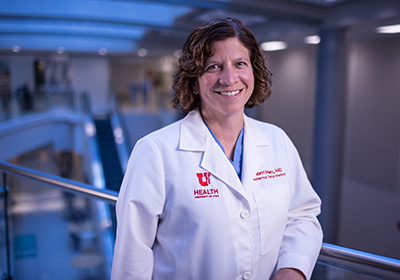University of Utah Health scientists are on the leading edge of a pair of large studies investigating the long-term effects of COVID-19. The nationwide studies, supported by the National Institutes of Health, will attempt to answer key questions about the lingering effects of the viral disorder on pregnant individuals and their infants, as well as why some people develop post-acute sequelae of SARS-CoV-2 (PASC), including “long COVID,” and others don’t.
PASC affects up to 30% of COVID-19 patients, causing a host of lingering and potentially serious symptoms. These include fatigue, breathing difficulties, memory problems, chest pain, and fast or pounding heart. The two groups are part of a larger NIH initiative, “Researching COVID to Enhance Recovery” (RECOVER) Initiative, which seeks to understand, prevent, and treat PASC.

Torri D. Metz, M.D., a University of Utah maternal-fetal medicine specialist. Photo credit: Charlie Ehlert
Assessing COVID-19’s impact on pregnancy, newborns
Among the vital but still unanswered questions about COVID-19 and PASC is what influence the disease may have on pregnant individuals and their infants.
“We really don’t understand right now what the long-term consequences are of getting COVID-19 in pregnancy,” says Torri D. Metz, MD, MS, a maternal-fetal medicine subspecialist and associate professor at U of U Health who is leading a multi-center effort seeking answers to this question.

Rachel Hess, M.D., co-director of the Utah Clinical and Translational Science Institute (CTSI). Photo credit: Charlie Ehlert
Previous research suggests that pregnant individuals who have severe COVID-19 are three times more likely to receive intensive care and twice as likely to die of the disease than those who aren’t pregnant. While transmission of the virus from mother to child during pregnancy is rare, up to 3% of babies born to women with COVID-19 test positive for the virus after birth.
“It’s possible that the disease may be different in pregnant women because their immune systems function a bit differently than in non-pregnant women,” Metz says. “In terms of offspring, we know how important the in-utero environment is for babies, and we’re concerned that the inflammatory process that occurs when patients who are pregnant get COVID-19 may affect the babies in utero and after they are born.”
Over the next four years, Metz and her colleagues from 12 other medical institutions nationwide involved in the Eunice Kennedy Shriver NICHD Maternal-Fetal Medicine Units (MFMU) Network will track the health of about 1,500 women who had COVID-19 during pregnancy and their children who were born in the following days, weeks, or months. They will also track the health of about 250 women who did not get COVID-19 during pregnancy and their offspring.
In particular, the researchers will be looking for any impairments in cognitive development or cardiovascular complications among the children as they grow. They will also compare the long-term effects of PASC on the mothers who had COVID-19 during pregnancy versus pregnant individuals who were uninfected.
Sorting out why some people get ‘Long COVID’
Rachel Hess, M.D., co-director of the Utah Clinical and Translational Science Institute (CTSI), leads an effort by the Mountain States PASC Consortium (MSPC), a coalition of five health care systems in Utah, Colorado, and New Mexico. The group will compare COVID-19 patients who have or have had PASC with those who had COVID-19 but did not develop long-term symptoms.
“My biggest hope for the MSPC study is that we can develop a better understanding of why some people are experiencing really debilitating PASC symptoms and eventually help them get back to normal—or as close to it as possible,” Hess says.
The consortium plans to recruit more than 900 adults, 18 and older, for the study, including a diverse set of volunteers from Hispanic, Native American, and rural populations within the Mountain West region.
“Because this is such a new syndrome, determining what is different about people who develop PASC as a result of having COVID-19 is an important task,” Hess says. “This study could help us better define what this syndrome is and improve our understanding of its biological basis.”
The MSPC study includes patients who have been newly diagnosed with COVID-19, as well as those who had COVID-19 throughout the pandemic. Others who have not been infected with SARS CoV-2, the virus that causes COVID-19, will be recruited as a control group.
“Tracking individuals who currently have COVID-19 could help us determine if there are any patterns early in the disease that lead some patients to develop PASC later on,” Hess says.
Rachel Hess, M.D., co-director of the Utah Clinical and Translational Science Institute (CTSI), leads an effort by the Mountain States PASC Consortium (MSPC), a coalition of five health care systems in Utah, Colorado, and New Mexico. The group will compare COVID-19 patients who have or have had PASC with those who had COVID-19 but did not develop long-term symptoms.
“My biggest hope for the MSPC study is that we can develop a better understanding of why some people are experiencing really debilitating PASC symptoms and eventually help them get back to normal—or as close to it as possible,” Hess says.
The consortium plans to recruit more than 900 adults, 18 and older, for the study, including a diverse set of volunteers from Hispanic, Native American, and rural populations within the Mountain West region.
“Because this is such a new syndrome, determining what is different about people who develop PASC as a result of having COVID-19 is an important task,” Hess says. “This study could help us better define what this syndrome is and improve our understanding of its biological basis.”
The MSPC study includes patients who have been newly diagnosed with COVID-19, as well as those who had COVID-19 throughout the pandemic. Others who have not been infected with SARS CoV-2, the virus that causes COVID-19, will be recruited as a control group.
“Tracking individuals who currently have COVID-19 could help us determine if there are any patterns early in the disease that lead some patients to develop PASC later on,” Hess says.


